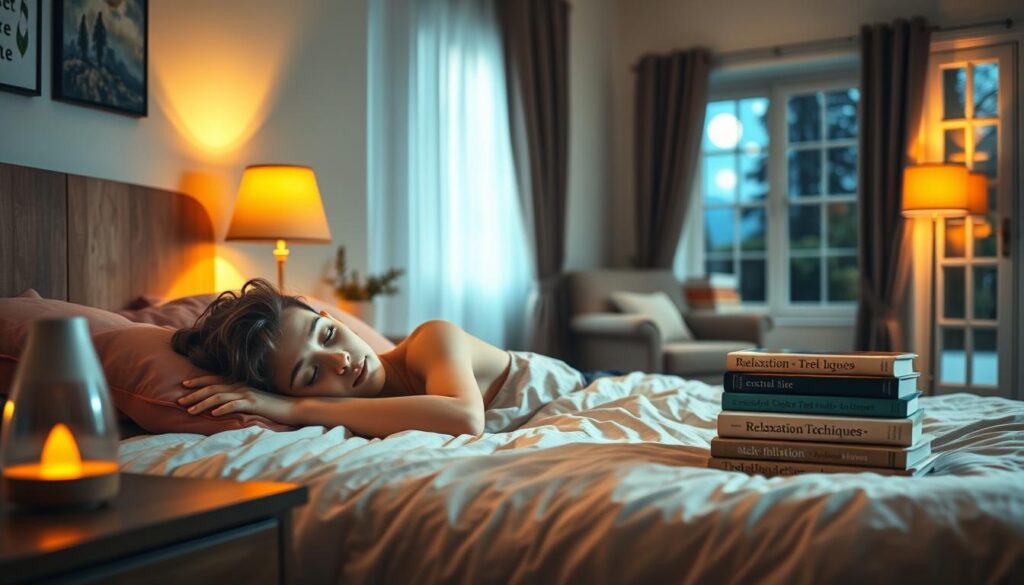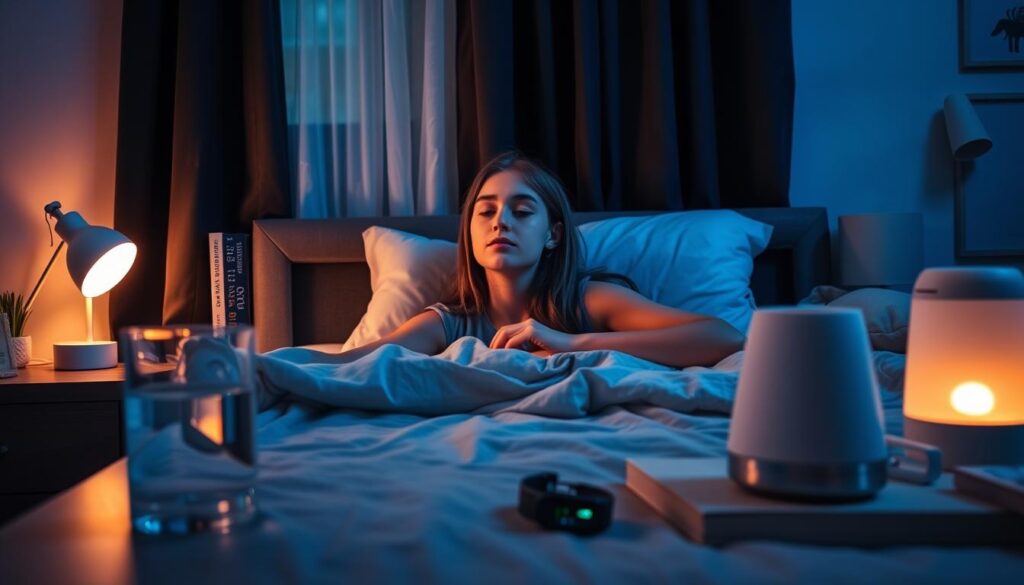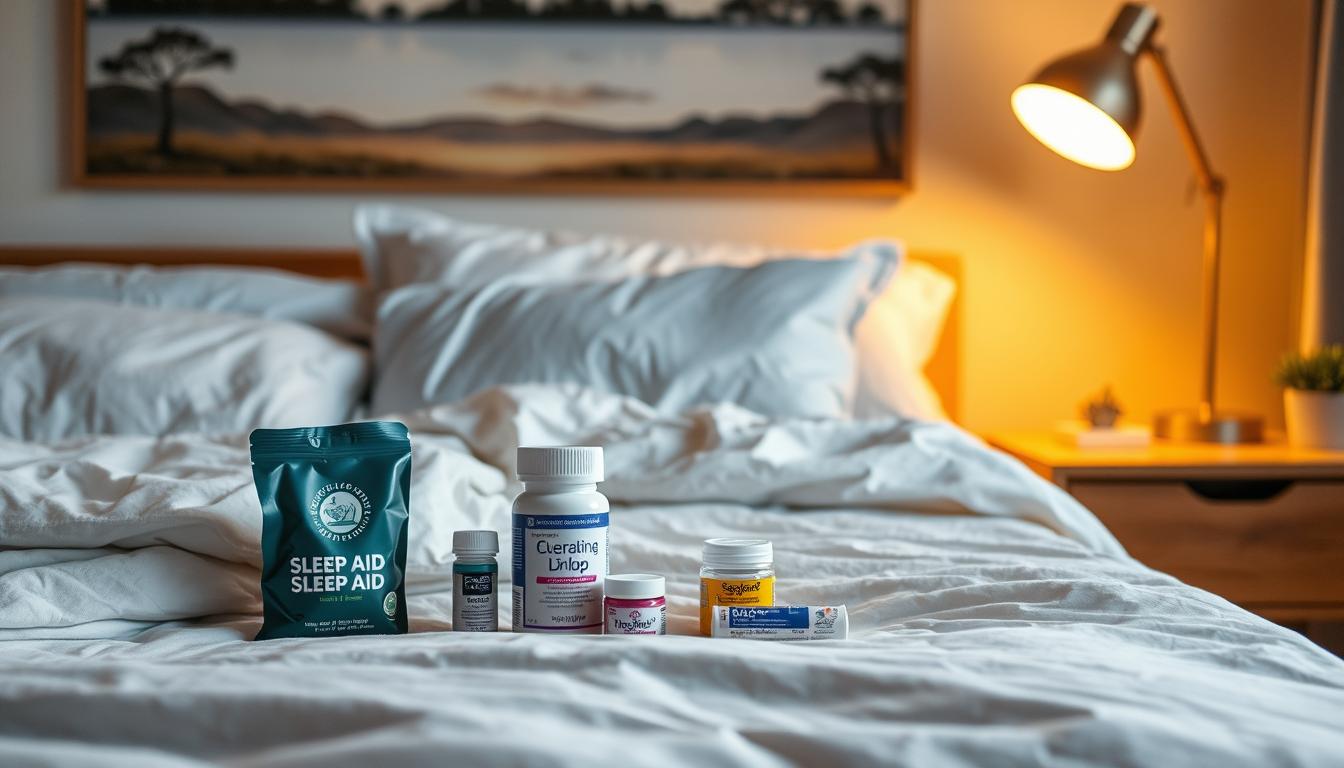Getting enough sleep is vital for teens to stay focused, healthy, and energized. This guide explores the best sleep aids for teenagers to help improve rest and address common challenges. From natural methods to trusted products, we’ll cover how to choose solutions that work.
Discover why sleep hygiene matters and preview our top recommendations. Learn how better sleep can boost school performance and daily well-being. This article breaks down science-backed tips and reviews of products designed for adolescent needs.
Key Takeaways
- Quality sleep boosts focus and teen mental health.
- Explore top sleep aids for teenagers to find the right fit.
- Simple routines and environment changes can improve rest.
- Understand how hormones and lifestyle affect sleep patterns.
- Learn to balance natural remedies and modern solutions.
Understanding Teen Sleep Challenges
Getting enough sleep is tough for many teens. Modern lifestyles create barriers that disrupt their rest. Let’s explore why this happens and how it affects their daily lives.
Common Causes of Sleep Disruption
- Screen time: Late-night scrolling on phones delays melatonin production.
- Academic pressure: Tests and deadlines keep minds active at bedtime.
- Irregular schedules: Weekend lie-ins throw off natural sleep cycles.
- Social demands: Late-night activities clash with early school hours.
Impact on Daily Life
Interrupted sleep doesn’t just mean tired mornings. Teens might struggle with:
- Slower focus in class, leading to lower grades.
- Mood swings affecting friendships and family life.
- Weakened immunity, causing more sick days.
Small changes can make a big difference. Next, we’ll look at how these challenges connect to their biology—and ways to tackle them without sacrificing fun or productivity.
How Poor Sleep Affects Teen Health
When teens don’t get enough sleep, their bodies and minds pay the price. Teen sleep health directly ties to their ability to focus in school, stay healthy, and manage emotions. Even one night of poor sleep can lead to headaches, irritability, or trouble remembering facts. Over time, chronic sleep loss weakens the immune system, making teens more likely to catch colds or the flu.
- Academic struggles: Grades drop when tired brains can’t retain information.
- Emotional highs and lows: Mood swings become common, making friendships and family life harder.
- Risk of chronic issues: Long-term sleep debt raises chances of diabetes, obesity, and mental health challenges.
“Teens needing 8-10 hours of sleep nightly often fall short, risking lifelong health patterns.”
Think of sleep as fuel. Without enough, the body can’t repair cells, and the brain can’t process memories. Small changes today—like turning off screens before bed—can make a big difference. Prioritizing rest isn’t just about feeling better tomorrow; it’s about building a healthier future.
Exploring the Science of Sleep and Teens
Behind every teen’s late-night habits lies biology. Let’s break down why their bodies resist early bedtimes and how hormones play a role in disrupted sleep.
“Teens aren’t being lazy—they’re biologically wired to stay up late and sleep in.” – National Sleep Foundation
Circadian Rhythms in Adolescence
Adolescents’ internal clocks shift as they grow. During puberty, their bodies release melatonin later at night, pushing sleep times to 11 p.m. or later. This clash with early school start times creates a “sleep debt” by morning.
- Natural wake-up time for teens often aligns with 10 a.m. or later.
- Light exposure at night delays this reset, making screens a double challenge.
Hormonal Changes and Sleep Patterns
Puberty floods bodies with growth hormones, stress hormones like cortisol, and adrenaline. These spikes can keep teens alert when they should wind down.
- Melatonin release—the “sleepy” hormone—starts 2 hours later than in kids.
- Stress from school or social pressures can spike cortisol, making falling asleep harder.
Understanding these shifts helps families adjust routines to match their biology. Science shows flexibility with bedtimes and morning schedules can ease the struggle.
Detailed Guide to the Best sleep aids for teenagers
Choosing the right sleep aid can help teens reclaim restful nights. Here’s a breakdown of top products and how to pick the best fit:
Overview of Top Products
| Product | Features | Best For | Price Range |
|---|---|---|---|
| Now Foods Melatonin | Natural, non-GMO, 100% melatonin | Occasional sleep disruptions | $10–$15 |
| Gravity 15lb Weighted Blanket | MicroGlass™ technology, calming pressure | Anxiety-driven restlessness | $150–$200 |
| LectroFan Premium | 50 white noise options, 20 fan sounds | Sensitive to noise or light | $50–$70 |
| Calm App | Guided meditations, sleep stories | Stress or overthinking | $10/month |
How to Choose the Right Aid
- Match the product to specific issues (e.g., anxiety vs. insomnia).
- Check for natural ingredients if avoiding medications.
- Budget: Prioritize cost-effectiveness without compromising safety.
- Consider ease of use—teens might prefer apps over devices requiring setup.
Always consult a doctor before starting new supplements. Prioritize solutions that fit their lifestyle and needs.
Natural Sleep Remedies for Teens: What Works
Many teens find relief with natural sleep remedies for teens that don’t involve medication. These methods focus on calming the mind and body, making them ideal for those seeking safe, non-invasive options. Simple lifestyle changes can improve sleep quality without relying on pills or supplements.
- Herbal teas like chamomile or valerian root: Brands like Yogi Bedtime Tea or Traditional Medicinals offer caffeine-free blends that promote relaxation.
- Mindfulness practices: Short meditation sessions or deep breathing exercises can ease stress. Apps like Calm or Insight Timer provide guided sessions under 15 minutes.
- Diet adjustments: Foods rich in magnesium (almonds, spinach) or tryptophan (bananas, turkey) support natural sleep cycles.
Consistency is key. Try one remedy at a time for 2-3 weeks to track results. For example, sipping a warm cup of Yogi Bedtime Tea 30 minutes before bed can signal the body it’s time to wind down. Pair this with a nightly routine like journaling or stretching to reinforce the sleep-wake cycle.
Parents and teens should consult a doctor before adding new supplements. Natural doesn’t always mean safe for everyone. Start small and track progress using a sleep diary to identify what works best. Small changes in routine can lead to big improvements in restfulness.
Insomnia Solutions for Adolescents: Overcoming Nights of Restlessness
Insomnia solutions for adolescents often hinge on small, consistent changes. Let’s explore strategies that turn restlessness into restful routines.

Behavioral Techniques
Behavioral shifts can rewire sleep habits. Cognitive behavioral therapy for insomnia (CBT-I) teaches teens to replace anxiety with positive sleep associations. Try these steps:
- Journal thoughts before bed to process worries
- Practice progressive muscle relaxation to ease tension
- Use visualization techniques to imagine calm environments
Lifestyle Adjustments
Small daily changes make a big difference. Limit screen time two hours before bed—blue light disrupts melatonin production. Adjust routines with these tips:
- Stick to a fixed bedtime even on weekends
- Replace late-night snacks with herbal tea or warm milk
- Make bedrooms screen-free zones to signal sleep mode
“A 2023 study in the Journal of Adolescent Health found teens who kept consistent schedules improved sleep by 30%.”
Combining these strategies builds habits that turn sleep struggles into restful nights. Every adjustment is a step toward better rest.
Evaluating Sleep Supplements for Teenage Sleep Problems
Choosing sleep supplements for teenage sleep problems starts with understanding safety and effectiveness. Supplements can help, but parents and teens must research ingredients and dosages carefully.
Safety and Efficacy
Look for sleep supplements with FDA compliance and clinical testing. Avoid products with caffeine or stimulants. Always consult a pediatrician before starting any supplement to avoid interactions with medications or health conditions.
- Check for FDA approval and third-party lab testing
- Start with low dosages and monitor results
- Avoid unverified online brands
Ingredient Breakdown
Key ingredients in sleep supplements for teenage sleep problems often include:
| Ingredient | Role | Examples |
|---|---|---|
| Melatonin | Regulates sleep-wake cycles | Now Foods Melatonin 0.5mg |
| Valerian Root Extract | Reduces anxiety | Nature’s Way Valerian Root Capsules |
| Zinc | Supports neurotransmitter function | Thorne Research Zinc Glycinate |
Always review labels for added sugars or fillers. Supplements should never replace medical advice for severe sleep disorders.
Choosing Recommended Sleep Products for Young Adults
When selecting recommended sleep products for young adults, prioritize safety, user reviews, and cost-effectiveness. Trusted brands like Philips and Gravity offer solutions backed by positive feedback.
- Safety: Look for FDA-approved devices or hypoallergenic materials.
- Reviews: Check ratings from verified buyers to gauge real-world performance.
- Value: Compare features against price to find balanced options.
| Product | Features | Pros |
|---|---|---|
| Philips SmartSleep Headband | Sleep tracking, sound therapy | Improved sleep cycles, FDA-cleared |
| Gravity Blanket 15lb | 100% glass beads filling | Reduces anxiety, adjustable weight |
| Withings Sleep Analyzer | Non-contact monitoring | Tracks without wearing devices |
Always read product descriptions carefully. Check if the product aligns with specific needs, like noise reduction or comfort. Consulting a healthcare provider ensures choices fit individual health conditions. Reviews from peers in forums or platforms like Amazon can highlight real experiences.
Focus on recommended sleep products for young adults that address personal sleep barriers. Balancing innovation with proven results helps avoid ineffective or unsafe options.
Practical Tips for Better Sleep in Teenagers

Small changes can make a big difference in helping teens catch more Z’s. Let’s explore easy steps to turn bedtime struggles into restful routines.
Establishing a Sleep Routine
A consistent schedule builds healthy habits. Try these steps:
- Set a fixed bedtime and wake-up time—even on weekends.
- Wind down with calming activities like reading or journaling.
- Avoid screens 1 hour before bed to reduce blue light exposure.
Creating a Sleep-Friendly Environment
Your bedroom setup matters. Use this checklist to optimize space:
| Aspect | Action | Benefit |
|---|---|---|
| Light | Use blackout curtains or an eye mask | Blocks disruptive light |
| Noise | White noise machines or earplugs | Muffles outside sounds |
| Temperature | Keep room cool (60–67°F) | Optimal for sleep cycles |
Experiment with these tips for better sleep in teenagers to find what works best. Consistency and patience are key!
Managing Teenage Sleep Disorders: Treatment Options
Addressing teenage sleep disorders requires exploring effective teenage sleep disorders treatment options tailored to their unique needs. Many teens struggle with irregular schedules or stress, but solutions exist to restore healthy sleep patterns.
- Cognitive Behavioral Therapy for Insomnia (CBT-I): A proven method to retrain sleep habits and reduce anxiety around bedtime.
- Prescription Medications: Doctors may recommend short-term use of sleep aids, but always under medical supervision.
- Lifestyle Adjustments: Consistent bedtimes, limited screen time, and calming routines can improve outcomes.
- Professional Counseling: Therapists help teens manage stress or mental health issues linked to sleep struggles.
“Combining therapy with practical changes often yields the best results for long-term sleep improvement.”
When selecting teenage sleep disorders treatment options, consult a healthcare provider to assess individual needs. Track progress by monitoring sleep quality and duration. Early intervention helps prevent long-term health risks. Prioritize treatments that balance safety and effectiveness for lasting benefits.
Top Sleep Aids for Adolescent Insomnia: What Sets Them Apart?
Not all sleep aids work the same for teens. The top sleep aids for adolescent insomnia offer features that address unique teenage needs. From tech-driven solutions to user-friendly designs, these products focus on what helps most.
Innovative Features
- Smart sensors track sleep stages and adjust lighting or sounds automatically.
- Apps with bedtime reminders and calming routines guide teens without screens.
- Adaptive mattresses and pillows use cooling materials to improve comfort.
User Success Stories
“My son uses the Withings Sleep Analyzer. It helped us spot his insomnia triggers and cut nighttime wake-ups by half.” – Sarah, Parent
Many teens find relief with tools like the Philips SmartSleep system. It uses sound therapy to calm racing minds. Others prefer weighted blankets like the Gravity Blanket, which eases anxiety before bed.
Look for aids that combine science with practicality. Products with proven results in studies, like melatonin sprays or white noise machines, often rank highest. Reviews show these options help teens fall asleep 20–30 minutes faster.
Effective Sleep Aids for Teens: User Reviews and Experiences
Real experiences with effective sleep aids for teens reveal what works best. Many parents and teens share how products like weighted blankets and sound machines improved rest. Read on to see what others have tried.
“Since using a melatonin gummy, my 15-year-old falls asleep faster. It’s made a real difference!” – Sarah, parent of a high school student
Common themes in reviews include:
- Comfort and ease of use
- Quick results vs. long-term benefits
- Budget-friendliness
| Product | Key Features | User Feedback |
|---|---|---|
| Nature’s Bounty Melatonin | 100% natural, sugar-free | “Helps me stay asleep longer.” – Teen user |
| Marpac Dohm Classic White Noise Machine | Adjustable sound levels, no electricity needed | “Blocks out distractions completely.” – Parent review |
| Withings Sleep Analyzer | Tracks sleep cycles without wearing a device | “Shows why I’m waking up at night.” – College student |
Reviews stress the importance of testing options. Some teens prefer tech-based solutions, while others rely on natural methods. Always pair products with good sleep habits like limiting screens before bed.
Conclusion
Quality sleep is vital for teenagers’ health and daily success. This article highlighted natural sleep aids like calming routines and sleep-friendly environments. Behavioral changes, such as avoiding screens before bed, and strategies like consistent bedtime schedules can improve rest. When choosing sleep aids, consider products that align with individual needs, like weighted blankets or apps tracking sleep patterns. Addressing sleep disorders early through professional guidance ensures long-term well-being. Small steps—like dimming lights or using white noise—add up to better rest. Prioritizing sleep supports focus, mood, and energy, setting teens up for daily challenges. By combining these approaches, teens and parents can create sustainable habits for healthier nights and brighter days.
FAQ
What are the best sleep aids for teenagers?
When it comes to the best sleep aids for teenagers, products like melatonin supplements, herbal remedies like chamomile, and magnesium tablets are popular choices. It’s essential to consider options with natural ingredients and consult with a healthcare professional for personalized recommendations.
Are there natural sleep remedies for teens?
Yes, natural remedies such as valerian root, lavender essential oil, and warm milk can help promote relaxation and improve sleep. Incorporating mindfulness practices and relaxation techniques into a bedtime routine can also significantly enhance sleep quality.
What can I do about insomnia solutions for adolescents?
Addressing insomnia in adolescents often involves a combination of behavioral techniques, such as cognitive-behavioral therapy (CBT), establishing a regular sleep schedule, and creating a calming bedtime environment that promotes restfulness.
Are sleep supplements safe for teenage sleep problems?
Many sleep supplements can be safe for teenagers when used appropriately. Look for products with well-researched ingredients like melatonin. Always consult with a healthcare provider to ensure safety and suitability for individual needs.
What sleep products are recommended for young adults?
Recommended sleep products for young adults include specialty mattresses, comfy pillows infused with cooling gel, and sleep masks that block out light. Products designed to enhance comfort and relaxation play a pivotal role in promoting better sleep.
What tips for better sleep in teenagers should I follow?
To improve sleep in teenagers, encourage a consistent bedtime routine, limit screen time before bed, and create a sleep-conducive environment by managing light, noise, and temperature levels in the bedroom.
What are the treatment options for teenage sleep disorders?
Treatment options for teenage sleep disorders may include cognitive-behavioral therapy (CBT), lifestyle adjustments, and, in some cases, medication prescribed by a healthcare professional to address specific issues like insomnia or sleep apnea.
What sets top sleep aids for adolescent insomnia apart?
Top sleep aids for adolescent insomnia often feature innovative technologies, such as sleep tracking capabilities and customizable settings, along with positive user reviews and success stories highlighting their effectiveness.
How can I evaluate effective sleep aids for teens?
When evaluating effective sleep aids for teens, consider the ingredients, user reviews, safety profiles, and recommendations from health professionals. Additionally, assess how the product aligns with individual sleep needs and preferences.
